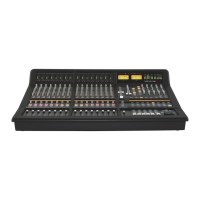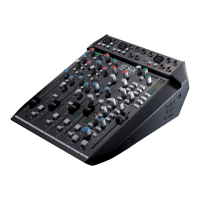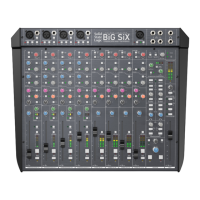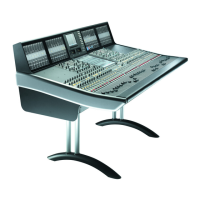AAuuttoommaattiioonn OOppttiioonnss
TTrriimm
Trim status (AKA Relative) originates from VCA (non-moving fader) automation systems and uses the fader to add
or subtract level from existing moves. It achieved this by setting up a ‘null’ fader position and then any subsequent
moves trim the existing data by the amount of positive or negative change from the null point. Trim is useful, for
example, when you have a automated a complex vocal line that needs raising by 2dB. Rather than trying to re-write
all the moves again, simply rollback, hit the TRIM button (in the ‘AUTOMATION’ group), and then move the fader
up by 2dB (the fader automatically enters Trim mode when it is moved, as indicated by the green fader status LED).
Locate to the end of the vocal line that needs this level increase, and press the END button to commit the trim to
a Mix Pass.
The brown (upper) line in this illustration shows the effect
of the trim.
Once the TRIM function is selected (button is lit), faders
can be put into Trim status at anytime in Mix Running or in
Mix Review using the fader status buttons, except during
the first Pass of a new Mix. Channel trim levels are shown
in the electronic scribble strip, and Group/Master trim levels
are shown underneath the fader levels in the Centre
Section TFT screen.
If Trim is selected at the start of an Update Mix, the FSM soft key will toggle all faders between Replay and Trim.
Trim can be used with the fader motors on or off (see Motors Off). If the motors are on, the null point will be
the fader position prior to selecting the fader status button, or touching the fader. If the motors are off, the fader
can be positioned at any suitable reference point on the scale, before entering Trim update status by pressing the
fader status button. Duality SE’s automation system features SSL’s ‘auto-nulling’ feature so that each time Trim is
re-enabled, a new null point is set (unless Trim Lok has been selected – see below). When writing a trimmed move,
the trim value in dBs is displayed in the scribble strip above the fader.
Using the AutoTakeover and Snap functions (see below) in conjunction with a Trim update allows a seamless
or smooth return to the stored mix data.
When Join is used with faders in Trim at the rollback point, any Trim offset will be retained and written from the
point that the JOIN button is pressed. Revise returns any fader in Trim at the rollback point back to Write but
with a new null point to avoid a level jump.
AAuuttoommaattiioonn
55--1177DDuuaalliittyy SSEE OOppeerraattoorr’’ss MMaannuuaall
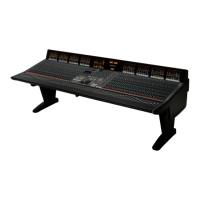
